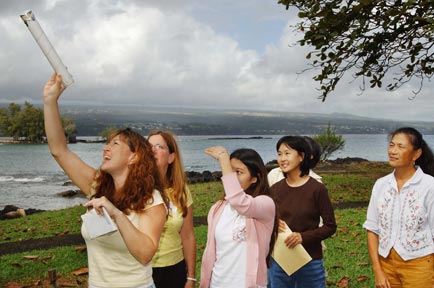 Teachers at a Journey through the Universe educator workshop in Hilo, Hawai’i, January 2006. 120 grade K-12 teachers received training on lessons from the Voyage K-12 Curriculum.
Teachers at a Journey through the Universe educator workshop in Hilo, Hawai’i, January 2006. 120 grade K-12 teachers received training on lessons from the Voyage K-12 Curriculum.
In the picture, the teachers are conducting the activity Sun – Ruler of the Solar System, as part of the grade 5-8 lesson How Far is Far?, where students determine the distance to the Sun and Moon. It is a first step to understanding the scale of the Solar System, and the reality of tiny worlds in a vast space.
The lesson starts with the class exploring how photographs are created, and the basic requirements for a camera—a box, a pinhole in one side, and an internal ‘screen’ on the opposite side—which makes photographs possible. Students propose and build a simple camera—a pinhole tube—with a paper towel tube, aluminum foil with a pinhole covering one side, and paper covering the other side and serving as a screen.
In the photo above, teachers are pointing their pinhole tube toward the Sun, which creates a small bright image of the Sun—a model of the Sun—on the screen at the back of the tube that is easily seen. The diagram below provides the geometry.
 In the diagram, the base of the big triangle is the diameter of the real Sun. Since the pinhole tube is here with us on Earth, the length of the big triangle is the distance between the real Earth and Sun. What’s cool is that the little triangle inside the tube is a little model of the big triangle, since it’s easily shown that both triangles are similar triangles.
In the diagram, the base of the big triangle is the diameter of the real Sun. Since the pinhole tube is here with us on Earth, the length of the big triangle is the distance between the real Earth and Sun. What’s cool is that the little triangle inside the tube is a little model of the big triangle, since it’s easily shown that both triangles are similar triangles.
By calculating the number of model Suns side-by-side that would span the length of the tube, the student is actually calculating how many real Sun’s side-by-side would span the real distance between Earth and Sun. The middle school student is measuring the distance to the Sun with a paper towel tube, small squares of aluminum foil and graph paper, and a couple of rubber-bands. Elegant inquiry-based science education doesn’t require a sophisticated laboratory apparatus, or even an expensive kit of materials.

